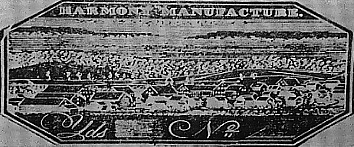Harmonie Indiana
![]() Harmonie Society Property, 1824
Harmonie Society Property, 1824
The Harmonie Society: In 1814, only a half dozen settlers lived in the area which later became Posey County when George Rapp (1757-1847) and his followers came up the Wabash River by flatboat and founded the community of Harmonie. In search of religious freedom, the Harmonists, a group of Lutheran dissenters, had left Germany in 1805 and settled in Butler County, Pennsylvania. In 1814, they came to the Indiana Territory and purchased government land at a location 50 miles south of Vincennes.
The Harmonie Society labored to create a cooperative community bound by the principles of celibacy, obedience to their leader and Christian communal living. Convinced that they were a chosen people, the Harmonists bent thought and practice to preparation for the millennium or Second Coming of Christ which they believed would come in their lifetimes. Nonetheless, within five years of their arrival, the Rappites had brought 1,450 acres of land under cultivation and built a community of 180 log, frame and brick buildings, some of which still stand. The almost completely self-sufficient town in the wilderness was a model for planning, order and cleanliness, with the society's total land holdings at about 20,000 acres and with an estimated value of $150,000. Despite this evident prosperity in Indiana, in 1825, Father Rapp sold the settlement with all its improvements to Robert Owen and William Maclure and led his flock back to Pennsylvania. At Economy, their new settlement, the Harmonie Society dwindled in numbers as a result of a schism in 1832 and the continued practice of celibacy.
 Label for wool manufactured by the Harmonie Society
Label for wool manufactured by the Harmonie Society
Prominent Harmonists include:
George Johann Rapp (1757-1847), founder and leader of the Harmonie Society, was born in Wurtemburg, Germany, as were most of his immediate family. In 1787, at the age of thirty, he formed his "church of the brethren." When pressed by the Lutheran Church to cease preaching in 1803, he visited the United States to look for a place to live. He found this in Pennsylvania, whereupon he returned to Germany and brought his followers back to America in 1805.
John (Johann) Rapp (1783-1812), son of George, brother of Rosina, and father of Gertrude Rapp. He served as his father's business manager until his death at 29.
Frederick Reichert Rapp (1775-1834), was the adopted son of George Rapp. He became the Society's business manager after John's death.
Rosina Rapp (1886-1849), daughter of George and sister of John Rapp. She was named after the rose flower, which became an important symbol to the Harmonists.
Gertrude Rapp (1808-1889), daughter of John Rapp.
